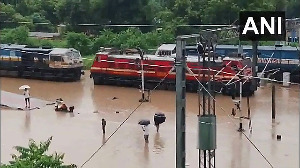Asserting that "more than expected" had been achieved during joint Indo-US naval exercises, US Commodore of Defence Staff Mike Smith said aboard INS Mysore on Thursday that he favoured more advanced exercises in next phase.
At the end of the first phase of the eighth Indo-US joint naval exercise 'Malabar-05,' Smith said he would recommend doing away with basic exercises and moving to more advanced exercises.
"With Malabar-05 exercise, we have accomplished more than what we expected," he told a joint press conference with Commanding Officer of Indian aircraft carrier 'INS Viraat' Captain S P S Cheema.
With the two navies taking up advanced exercises, including war-at-sea on Friday, Smith said he was "extremely impressed by joint exercise so far which has brought to the forefront many similarities between two navies and shown that both together can compliment each other in achieving goals (of security), including regional security in this part of the world," he said.
Indian, US aircraft carriers go head-to-head
'Malabar-05' witnessed participation of aircraft carriers from both sides for the first time. The 'USS Nimitz', an aircraft carrier which can hold over 100 aircraft in its belly, participated in the first phase.
Apart from 'USS Nimitz', US nuclear submarine 'USS Santa Fe' was also a highlight of the exercise, with Indian participation coming in the form of 'INS Shankul'.
Over 12,000 personnel from both sides are participating in the exercises, primarily aimed at developing inter-operability confidence to tackle piracy, terrorism and relief and rescue issues in the region and elsewhere. The exercises also witnessed exchange of officers and sailors by both navies on vessels and operating aircraft and helicopters.
While helicopters from both sides conducted landings on each others vessels, the fighters did not land due to operational reasons, Indian naval authorities said.
Cheema said 'Malabar-05' exercise was 'different' since it witnessed participation of aircraft carrier from both sides.
"The moment you have aircraft carriers participating, the dimensions of the exercise change. With the carriers, you have fighters and the inter-operability challenges grow," Cheema said.
Participation of aircraft carriers on both sides is indicative of both navies endeavouring in high-level of inter-operability, he said, adding that in the first phase, Indian 'Sea Harrier' and American 'F-18s' got engaged in air combat, controlled by American 'E2C Hawkeye' aircraft and 'INS Viraat.'
According to Indian Naval officials, the exercise provided large canvas on which both navies operated and the entire experience was professionally stimulating and gratifying.
Captain Cheema informed that the second phase will have submarine to submarine exercises and a 24-hour war-at-sea aimed at exercising mission skills of the two navies in a complex scenario.





